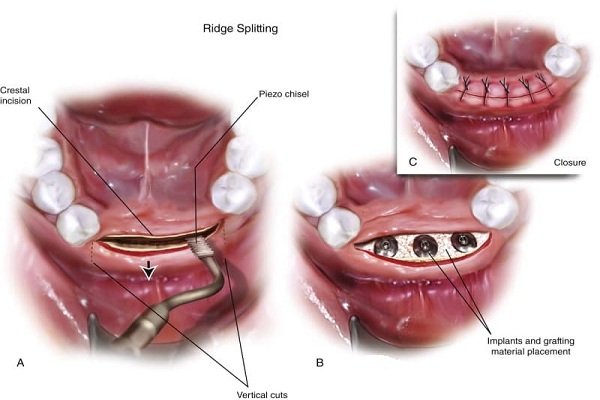Our Specialist Doctors Perform Advanced Dental Procedures At Perfect Dental® In Jamnagar
Alveoloplasty is a dental pre-prosthetic procedure to smoothen or reshape the jawbone after extractions to allow dentures to sit well


An Alveoloplasty is a surgical procedure that reshapes and smoothens out the jaw where a tooth or teeth have been extracted or lost. The part of the jawbone that houses the teeth is called the alveolus and “plasty” means molding, so Alveoloplasty is the process of molding or reshaping the jaw.
When a tooth is extracted, the socket (the hole where the tooth was located) heals over the course of several weeks. However, once healed, the area may not be ready for a tooth replacement, such as a denture, bridge or implant. The healed area is called an edentulous ridge and it may be uneven or bumpy, which will not allow for a nice fit of the replacement tooth or teeth. Smoothing out the jawbone prepares the mouth for successful placement of the new artificial tooth.
The procedure can be performed either at the time of tooth extraction or after the site has fully healed. When you prepare for your tooth extraction, your dentist will evaluate your jaw and decide if it needs recontouring.
Dentists often conduct this procedure at the same time as the tooth extraction to shape the jawbone in a way that facilitates healing. Alternatively, the procedure can be performed once the site has healed but before the artificial tooth has been placed to make sure the shape of the jaw supports the new device.
The main purpose of alveoloploasty procedure is to recontour and restructure alveolar bone to provide a functional skeletal relationship.
Indications of alveoloplasty should nevertheless include recontouring or reshaping alveolar bone during tooth extraction surgery. For instance, if alveolar bone has sharp edges after tooth removal, it is necessary to smoothen the bone surfaces to facilitate tooth socket healing process and to avoid any procedural complications such as pain or long standing open wound.
The next indication for Alveoloplasty involves a standalone procedure which is usually done prior to treatment planning of any prosthetic appliances such as placement of fixed or removable prosthetic appliances. In relation with the first point of indication of the procedure, the bone contouring after dental extractions also helps in preparation for prosthetic rehabilitation. This serves as an important procedure as any sharp bony projections under removable appliances such as dentures will cause discomfort and pain when patient perform masticatory functions.
In either scenario — during tooth extraction or after healing — the patient will be under local anesthesia for the duration of the procedure. This ensures that the patient feels no pain. The dentist will make an incision at the gumline to expose the underlying jawbone. With a chisel or a burr on a handheld drill, the dentist will adjust the bone to the desired shape. They will close the gum tissue with stitches to allow for proper healing.
Alveoloplasty is a fairly common procedure designed to prevent complications with tooth replacements. Once you have a smooth jawbone, your mouth will be ready for a dental fixed replacement tooth, such as a dental implant. Your dentist will be able to identify if you might benefit from this surgery and provide a recommendation on when it should be performed. Their guidance is aimed at improving your oral health and helping you achieve your ideal smile.
Alveoloplasty is a surgical procedure performed at Perfect Dental® to reshape and contour your jawbone. It is often needed if before being fitted for dentures so they can fit snuggly. Other times an alveoloplasty is used if you have bone spurs on your jaw, especially after a tooth extraction.
Alveoloplasty is done under local anesthesia and hence there is no pain felt during the procedure. Most surgeons prescribe antibiotics to avoid bacterial infection from setting in. Meanwhile, most patients complain of post-operative pain in the surgical area for several days, which can be addressed by taking painkillers and required rest. The surgical site may also experience swelling and tenderness to touch.
Alveoloplasty, in conjunction with extractions, is a surgical procedure that recontours the alveolar bone and is usually performed to prepare the alveolar ridge for a dental prosthesis.
Alveoplasty can be recommended for patients following their tooth extraction to smooth out any rough bone ridges and remove any irregularities in the jawbone. This prepares the jawbone for the placement of dental prostheses such as dentures.
– Bleeding is profuse (choking on blood).
– Bleeding is continuous (still changing bright red gauze after 24 hours).
– Severe pain not well controlled by medications.
– Rash, hives or difficulty breathing after taking the medications that suggest an allergic reactions.
– Persistent fever lasting more than 24 hours.
– Discharge coming out from the surgical site.Perfect Dental® is the best dental clinic in Jamnagar and our team of specialist doctors is highly skilled and experienced best dentists in Jamnagar. We have a highest success rate of 97%.